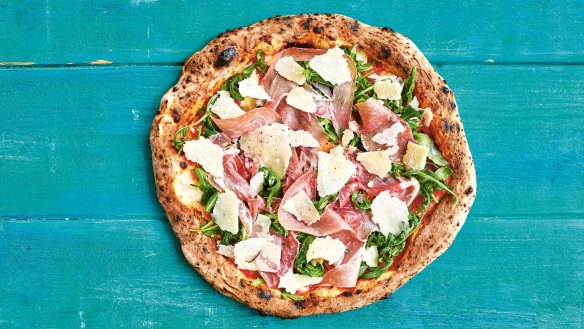How to make three classic Naples-style pizzas in a frying pan
Updated , first published

Everyone loves pizza, right? For brothers Thom and James Elliot, it's become an obsession. The British pair ditched their jobs eight years ago to make a food-lovers' pilgrimage to Naples, the home of pizza, where they learnt from the masters.
Back at home, they set up a stall in Soho selling pizza from the back of a van. Their business, Pizza Pilgrims, now runs more than a dozen pizzerias across London and the south-east of Britain.
Along the way, the brothers came up with their own method for making classic Neapolitan pizza using only a frying pan and oven.

Here, they share three recipes from their new cookbook, Pizza: History, Recipes, Stories, People, Places, Love.
Margherita
Where pizza all began … we can still remember the first time we tried a proper Neapolitan margherita in Da Michele in Naples. The mozzarella had been made that day and was perfect. The combination of the light, charred pizza dough, sweet tomatoes, aromatic basil, peppery olive oil, savoury parmesan and the milky white, creamy and slightly acidic mozzarella, just creates the most perfect flavour balance, which is the reason that the margherita is the undisputed heavyweight champion of pizza. It is always the pizza that any pizza chef would order to get the measure of a new pizzeria because there is nothing to hide behind; no snazzy flavours to mask the quality of your ingredients, dough and skill in the oven.
INGREDIENTS
For the pizza
- 1 ball of Neapolitan pizza dough (see below)
- 80g tomato sauce (see below)
- 4-5 fresh basil leaves
- parmesan, for grating
- 1 tbsp olive oil
- 80g fior di latte mozzarella, torn or sliced
METHOD
- Preheat the oven grill to its absolute highest setting, and place a large, ovenproof frypan (skillet) over a high heat on the stove and let it get screaming hot.
- Meanwhile, flatten and stretch the dough ball to make a 25-centimetre pizza base.
- Lay the pizza base flat in the hot, dry frying pan, then, using a small ladle (or a large spoon), spoon the tomato sauce onto the middle of the pizza. Using the back of the ladle, make concentric circles to spread the sauce, beginning in the middle and finishing 3½ centimetres from the edge.
- Next, sprinkle over the basil (it will burn if put on last). Grate over a little parmesan and drizzle with the olive oil.
- Once the base of the pizza has browned, about 1-2 minutes, add your mozzarella, then place the frying pan under the grill on the highest shelf.
- Once the crust has taken on some colour, about 1-2 minutes, the pizza is ready!

Eggplant parmigiana
We wanted a pizza on the menu that would be both vegetarian and a real comfort food hit. The one dish that makes all our pizzaioli go weak at the knees, except pizza, is eggplant parmigiana. So, we put it on a pizza.
INGREDIENTS
For the parmigiana
- 2 eggplant, cut into 2cm cubes
- 3 garlic cloves, finely chopped
- 100ml (scant ½ cup) good-quality olive oil
- 50g tomato paste
- 2 x 400g cans quality peeled plum tomatoes
- 100ml (scant ½ cup) water
- a small handful of basil leaves
- salt and freshly ground black pepper
Makes enough for 5 pizzas
INGREDIENTS
For the pizza
- 1 ball of Neapolitan pizza dough (see below)
- 4-5 basil leaves
- parmesan, for grating, plus 5g shavings to finish
- 1 tbsp good-quality olive oil, plus extra for drizzling
- 25g cherry plum tomatoes
- 80g fior di latte mozzarella, torn or sliced
METHOD
- First, toss the eggplant cubes in salt in a colander set over a bowl and leave for at least an hour. Preheat your oven to 230C fan-forced (250C conventional).
- Add your garlic and olive oil to a large, ovenproof saucepan and place over a medium heat. Slowly cook until the garlic is golden brown.
- Dry the eggplant cubes with a clean cloth, then add them to the pan and cook until the eggplant has softened.
- Stir in the tomato paste and cook for a further 3 minutes, then add the canned tomatoes and water. Place in the hot oven (with the lid off), stirring occasionally for 30-40 minutes until the sauce has reduced and the eggplant is soft and tender. Season with salt and pepper to taste and leave to cool.
- Preheat the oven grill to its absolute highest setting, and place a large, ovenproof frypan (skillet) over a high heat on the stove and let it get screaming hot.
- Meanwhile, flatten and stretch the dough ball to make a 25-centimetre pizza base.
- Lay the pizza base flat in the hot, dry frying pan, then spread over 100g of the eggplant parmigiana. Top with the basil, a grating of parmesan, the tablespoon of olive oil and cherry tomatoes.
- Once the base of the pizza has browned, about 1-2 minutes, add the mozzarella, then place the frying pan under the grill on the highest shelf.
- Once the crust has taken on some colour, about 1-2 minutes, finish the cooked pizza with the parmesan shavings and a drizzle of olive oil.

Prosciutto crudo, rocket and parmesan
OK, so we've had time to think about it. Porchetta is definitely the Humvee of hams, leaving the Rolls Royce spot free for infinitely elegant prosciutto di Parma DOC. We challenge you to add a few thin slices of this amazing cured meat to any pizza and not make it more delicious! We were lucky enough to visit the prosciutto di Parma factory and see the painstaking detail that goes into creating this world-renowned ingredient. This pizza is an ode to the Italian classic flavour combo of these three ingredients.
INGREDIENTS
- 1 ball of Neapolitan pizza dough (see below)
- 80g tomato sauce (see below)
- 4-5 basil leaves
- parmesan, for grating, plus 15g shavings, to serve
- 1 tbsp good-quality olive oil, plus extra to finish
- 80g fior di latte mozzarella, torn or sliced a small handful of rocket leaves
- 3-4 slices of prosciutto crudo
METHOD
- Preheat the oven grill to its absolute highest setting, and place a large, ovenproof frypan (skillet) over a high heat on the stove and let it get screaming hot.
- Meanwhile, flatten and stretch the dough ball to make a 25-centimetre pizza base.
- Lay the pizza base flat in the hot, dry frying pan, then, using a small ladle (or a large spoon), spoon the tomato sauce onto the middle of the pizza. Using the back of the ladle, make concentric circles to spread the sauce, beginning in the middle and finishing 3½ centimetres from the edge. Then add the basil, a grating of parmesan and the tablespoon of olive oil.
- Once the base of the pizza has browned, about 1-2 minutes, add the mozzarella then place the frying pan under the grill on the highest shelf.
- Once the crust has taken on some colour, about 1-2 minutes, you have to act fast. Scatter over a bed of rocket, lay the prosciutto slices over the top, then finish by sprinkling the parmesan shavings over everything and adding a good drizzle of olive oil.
How to make Neapolitan pizza dough
INGREDIENTS
- 1kg '00' flour (we recommend Caputo "blue")
- 2g (⅔ tsp) fresh yeast
- 620ml tepid water
- 30g fine sea salt
METHOD
- Make a mountain of flour in the middle of the table. Using your fist, make a deep well in the middle of the flour, exposing the surface of the table (turning your mountain into a moon crater).
- Crumble the yeast into the tepid water. Use your good hand to mash up the yeast in the water until it has dissolved. (Keep the other hand dry for taking Instagram photos to show off to your friends.) Fill your crater of flour with a third of the yeast/water mix. Using your fingertips, start making very small circular motions to combine the flour and water.
- Start dragging in some more flour to the mix, by "undercutting" the walls of the crater with your fingertips. As you do this the mixture in the middle will become thicker. Once it reaches the consistency of porridge you need to add a bit more water. Don't let it get too thick; if it starts to form a dough too soon it becomes difficult to incorporate the rest of the water. Keep dragging in a little flour to thicken the mix, then pouring a little bit more water in to loosen it, until you have used up all the water.
- Sprinkle the sea salt over the mixture while it's still very wet to ensure it dissolves and disperses evenly throughout the dough. Now use both hands to push the remaining flour from the outside into the middle. Fold and press the mix until all the flour is absorbed and a dough comes together. If you have a dough scraper it really helps get everything off the table, but you can improvise with a paint scraper, spatula or knife.
- Work the gluten by kneading the dough. Use the heel of your hand to stretch out the dough and roll it back up, while the other hand acts like an anchor. You'll be able to see the strands of gluten stretching, breaking, being put back together and becoming stronger. Continue this for about 8 minutes until the dough becomes smooth and glossy. It should also feel tighter and elastic.
- Let the dough have a 10-minute rest to relax the gluten. Cover the dough with a damp cloth or some cling film to keep the air from drying it out. Then divide your bulk of dough into individual portions. We recommend 230g dough balls for 25-centimetre pizzas. Ensure your dough balls are neatly shaped – pinched at the bottom and tight on the top – then place them in a tray or container 3cm apart. Cover with a tight lid or cling film.
- Now you can relax. The yeast will take over from here. Leave the dough at room temperature for approximately 6 hours until it expands to almost double its size, then store in the fridge overnight. The next day remove the dough from the fridge for 1-2 hours and bring it back to room temperature before making your pizzas.
How to stretch your own pizza base
- Place your dough ball on a lightly floured surface then generously dust with more '00' flour. The dough ball should be completely covered in flour, as you don't want any sticky spots.
- Using your fingertips, press out the dough ball firmly, starting at the centre and working your way out to the edges. It's important that this motion is a "push down" and not a "stretch out". As you push out to the edges, leave the last few centimetres of the dough untouched. This will become your crust.
- Turn the dough over and repeat the process. The aim is to end up with a circle of dough about half the size of the final pizza, with a thin middle and raised crust.
- Transfer the pizza base to the back of your hands. The edge of the crust should rest on your knuckles, with the rest of the base hanging down.
- Now start stretching the dough between your hands. Try to stretch the outside edge, rather than the centre, as it will become too thin. Keep rotating the pizza base until you have arrived back where you started. Now you should have a 25-centimetre pizza base with a raised crust and a beautifully thin middle. If you hold it up to a light you should almost be able to see through it.
How to make tomato sauce
INGREDIENTS
- 1 x 400g can of San Marzano (or any good-quality Italian) tomatoes
- a good pinch of sea salt
METHOD
- In a large bowl, crush the tomatoes by hand. (This is the old-school way they used to do it in Naples, and for good reason. If you put the tomatoes in a food processor you end up with a depressingly smooth sauce that lacks texture.) Once you've crushed the hell out of your tomatoes, add a pinch of salt to taste and that's it! Pure, unadulterated tomato goodness.
Makes enough for 4 pizzas
This is an edited extract from Pizza: History, Recipes, Stories, People, Places, Love by Thom and James Elliot, published by Hardie Grant Books, RRP$39.99. Photography by Dave Brown. Buy now
Appears in these collections
From our partners
Original URL: https://www.smh.com.au/goodfood/how-to-make-three-classic-naplesstyle-pizzas-in-a-frying-pan-20201106-h1s025.html